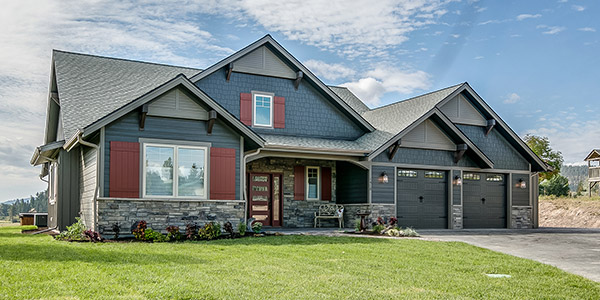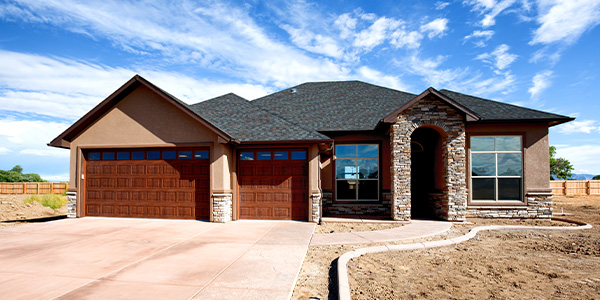Homebuyers
How Much is a Mortgage on a $300,000 House?
April 12, 2024
For the average American, a home is the largest purchase they will make in their lifetime. Luckily, being approved for a mortgage means you won't need to pay a home's full sale price at closing. However, that doesn't mean that a home's sale price doesn't matter.
Along with your interest rate and property taxes, your home's purchase price influences your monthly mortgage payment. How much is a mortgage on a $300,000 home? This question presents the perfect starting point for exploring how much mortgage you can afford as a first-time homebuyer.
Understanding Mortgage Basics
A mortgage is a type of loan used to finance the purchase of a property. Under a loan agreement, a borrower agrees to pay the lender back over time with interest. With a standard mortgage, the total payment is divided into monthly payments that are split between interest and principal. Here are some key mortgage terms to know:
- Mortgage Principal: The amount being borrowed from a lender to purchase a home.
- Mortgage Interest Rate: Expressed as a percentage rate, your mortgage interest is the annual cost charged for borrowing money.
- Term: The length of the loan. In most cases, the mortgage term is either 15 or 30 years.
- Amortization Schedule: The timetable that breaks down monthly payments into interest and principal.
- Down Payment: An initial payment made toward the purchase of a property.
- Collateral: The asset that a borrower offers as a guarantee for the mortgage. This is almost always the property that's being mortgaged.
Factors Affecting Mortgage Payments
The cost of owning a $300,000 home won't necessarily be the same for every buyer. Here's a look at the factors that go into what your monthly payments might look like.
Interest Rates
Borrowers are generally offered interest rates based on a mix of current rate trends and personal credit history. A higher interest rate increases both the overall cost of a mortgage and a borrower's monthly payments. In some cases, borrowers purchase mortgage points to bring rates down.
Loan Term
A loan's amortization rate is determined by its term. While loan terms can technically last just one to 10 years, the two most common mortgages are 15-year and 30-year mortgages. Borrowers who select shorter terms often pay off mortgages faster using lower interest rates in exchange for higher monthly payments.
Down Payment
While minimum down payment requirements can range from zero to 20% based on the type of loan, a larger down payment will generally reduce monthly mortgage payments.
Mortgage Types
The type of mortgage a borrower selects also impacts the cost of owning a $300,000 home. Here's how some options might look:
- Fixed-rate: Also known as a standard or traditional mortgage, a fixed-rate mortgage has an interest rate that remains steady for the full loan term. A borrower's interest rate and monthly principal and interest payment are set for the life of the loan.
- Adjustable-rate: Known as an ARM, an adjustable-rate mortgage has a variable rate that may change periodically over the life of the loan based on changes in the financial index linked to the loan. As a result, monthly payments can either increase or decrease to correspond with the index.
- FHA: An FHA loan offered through an approved lender is an insurance-backed loan through the Federal Housing Administration (FHA). FHA rates can be lower compared to traditional rates because lenders are protected.
- VA: VA home loans are guaranteed by the Department of Veterans Affairs. Their rates can be lower compared to traditional loans. They also don't require down payments.
Calculating Mortgage Payments for a $300,000 House
We make it easy to figure out the mortgage payments for a $300,000 home. Simply plug different down payments and interest rates into this mortgage calculator and you can see how much your payments might be.
What to Know About Rates and Terms
Most Americans today select fixed-rate mortgages because a fixed rate protects a borrower from sudden increases in monthly payments if rates rise. That can make long-term financial planning easier. Fixed-rate mortgages are also fairly easy to understand for the average buyer. Most people also select a 30-year loan term when buying a home.
While more of your payment goes to interest with a 30-year term, homeowners enjoy lower monthly payments that can make homeownership more affordable. A 15-year term is more commonly used by someone who either has a goal of being mortgage-free early or intends to move before interest payments rise.
Mortgage Insurance
If you put down less than 20% on a Conventional loan, your lender will require you to pay Private Mortgage Insurance (PMI) until the loan balance reaches 78% of a home's purchase price. On average, PMI costs between 0.46% and 1.5% of a loan amount. All FHA loans require a mortgage insurance premium (MIP) that may total between 0.55% and 0.85% of the total loan amount.
Closing Costs
Closing costs are expenses outside of a home's price that are due at closing. Common closing costs include:
- Origination fees
- Escrow deposit
- Appraisal fees
- Property taxes
- Deed recording
- Title insurance
- Attorney fees
- Survey fees
- Underwriting fees
- Prepaid interest
- Discount mortgage points paid to the lender
Closing costs generally cost 2% to 5% of a loan amount. Some sellers will negotiate to cover a portion of a buyer's fees as an incentive to close. While closing costs are not generally considered negotiable between the lender and borrower, borrowers can shop around to compare fees among lenders.
Additionally, some lenders offer no-closing-cost mortgages that allow buyers to roll closing costs into the mortgage amount. This option requires you to pay a higher interest rate on a larger loan over time in exchange for a virtually cash-free closing.
Additional Costs to Consider
Here's a look at other costs that can influence the monthly mortgage payment of $300,000:
- Property Taxes: Property taxes vary by state and city. If your property taxes are paid through your lender, the total is divided into 12 monthly payments that are added to your monthly mortgage total.
- Homeowners Insurance: Lenders require borrowers to carry insurance to cover a home's replacement cost. Premiums can potentially add thousands of dollars to the cost of homeownership each year.
- Private Mortgage Insurance (PMI): As covered above, loans with down payments below 20% require a PMI that can total 0.46% to 1.5% of a loan amount.
- Maintenance and HOA Fees: While maintenance and HOA fees aren't lumped in with mortgage payments, they should be accounted for when determining your monthly mortgage budget. HOA fees around the country average just below $200 per month.
Mortgage Preapproval and Application Process
A pre-approval letter is proof that a lender is willing to lend to you upon confirmation of the financial details you've provided. Real estate agents generally require a buyer to have a mortgage preapproval letter from a bank before they will begin showing them properties. Documents needed for preapproval include:
- Valid identification
- Employment verification
- Income verification
- Debt-to-income (DTI) proof
- Credit history
While there is no minimum income requirement to qualify for a mortgage, lenders do have certain standards that take into account a borrower's income, debt, and down payment. Even someone with a high income may not qualify for a mortgage if they have a heavy debt-to-income ratio. Debt-to-income ratio refers to monthly income in versus debt payments out. Lenders generally only approve mortgages for borrowers with DTIs below 36%.
When reviewing all of the documents needed for a home loan, a borrower's credit score is one of the strongest factors lenders look at because it's considered an indicator of their ability to pay back a loan. In most cases, better credit scores can qualify borrowers for lower interest rates. According to Experian, these are the credit score ranges:
- Exceptional: 800 to 850
- Very Good: 740 to 799
- Good: 670 to 739
- Fair: 580 to 699
- Poor: 300 to 579
Borrowers below the "fair" category are unlikely to qualify for mortgages. While FHA borrowers with credit scores as low as 580 may qualify, they may pay higher interest rates to offset risk.
Determining Your Down Payment
While the standard advice is to put down 20% to reduce monthly payments while avoiding PMI, many borrowers put down 10% or less. The advantage of putting down a lower down payment is that you may be able to get into a home at the right time instead of continuing to wait until you've saved a full down payment. In some cases, a buyer may save money by purchasing a home at a lower price today with a higher interest rate compared to continuing to wait until they have 20% available.
Tips for Choosing the Right Mortgage
Spend time comparing rates, terms, and fees between lenders to find the best mortgage. Rates may vary between lenders. You may also find that one lender's fees, options for purchasing mortgage points, reputation, and customer service simply make you feel more comfortable. Finally, spend time reviewing your financial situation to determine the type of mortgage that works best for you.
If you're looking for predictable payments that will allow you to comfortably stay in your home for the foreseeable future, a fixed-rate 30-year mortgage is often the default choice. If you're transferring to an area for what you expect to only be a few years, taking advantage of lower introductory rates on an adjustable-rate mortgage may be a good strategy. Ultimately, talking to a lender about what the numbers might look like with different types of loans is the best way to get a true idea of what the mortgage payment of $300,000 will look like for you.








 Smart Moves Start Here.
Smart Moves Start Here.